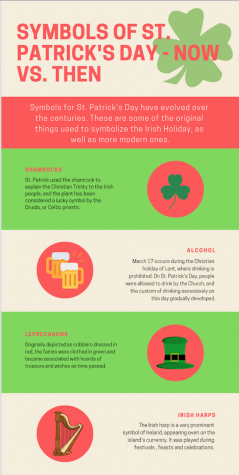The fading green of St. Patrick’s Day
How St. Patrick’s Day and other holidays have lost their original significance
March 18, 2019
Step out into the streets of nearly any major U.S. city on March 17, and you’ll be greeted with seas of green — people jumping around in leprechaun outfits or clad head to toe in green. It is a day when, if you are found without an inch of green somewhere on your body, you may be subjected to pinches and prods throughout the day. A day when elementary school students proudly walk around carrying leprechaun traps, hoping to be the lucky one who catches a leprechaun and win its hoard of gold treasure ⎯ St. Patrick’s Day.
The holiday was originally dedicated to St. Patrick, the patron saint of Ireland, and is celebrated on the date of his death on March 17, 461. Though little is known about his life, Patrick was born in Roman Britain and was initially brought to Ireland as a kidnapped slave at the age of 16. He escaped the island six years later, but later returned to spread Christianity on the island. St. Patrick’s Day then developed into a huge, festive holiday where people attended religious services in the morning and held exorbitant feasts in the afternoon.
 Nearly 13 centuries later, the holiday grew in popularity largely due to the efforts of Irish immigrants hoping to escape starvation from the Great Famine. Cities with large Irish-American populations began holding celebrations and small parades. Today, New York City hosts the largest civilian parade in celebration of St. Patrick, with over 150,000 participants each year, and the city of Chicago pours 40 pounds of orange, vegetable-based dye into its river each year to give it a bright green shade.
Nearly 13 centuries later, the holiday grew in popularity largely due to the efforts of Irish immigrants hoping to escape starvation from the Great Famine. Cities with large Irish-American populations began holding celebrations and small parades. Today, New York City hosts the largest civilian parade in celebration of St. Patrick, with over 150,000 participants each year, and the city of Chicago pours 40 pounds of orange, vegetable-based dye into its river each year to give it a bright green shade.
But the emerald green waters of the Chicago River and packed parades are a far cry from the original St. Patrick’s Day, which was dedicated to celebrating the life of a Roman slave who used the three-leaf clover to explain the Christian Trinity. The green-dyed beer and corned beef of today don’t at all resemble the traditional foods eaten after mornings of worship services. Even green, the color representative of the Irish holiday, isn’t traditional – it was only used following the Irish Rebellion, over 13 centuries after the original celebration, when Irish soldiers donned green uniforms to symbolize their rebellious stance against the British.
The holiday has lost its true meaning; like clay, it has been molded by the hands of commercialism and baked in the kiln of capitalism, emerging unrecognizable when compared to the original holiday. Most of its significant cultural value has been lost among cute, clean-cut leprechauns that litter stores during March. The patron saint of Ireland has disappeared in everything except for name, forgotten in favor of pots of gold at the end of rainbows.
This isn’t an isolated case; many of the holidays that Americans celebrate have gone through similar changes. Valentine’s Day, a holiday dating back to the Roman Empire to celebrate St. Valentine, the Roman patron saint of lovers, has been transformed into a day of swapping cards and candy with friends and loved ones. The Fourth of July, rather than being seen as a day commemorating the creation of the Declaration of Independence, is celebrated by most with backyard barbecues, pool parties and thousands of dollars in fireworks.
That is not to say, however, that all of our modern celebrations should be scrapped in favor of the original traditions. The changes holidays have gone through over the years are reflective of the country’s changing interests, and trying to revert back to older forms of celebrations would probably be favored by few. But the original significance of holidays, whether they be religious or cultural, should not be ignored.
Holidays shouldn’t just be regarded as days off from school. They shouldn’t be used just as excuses to splurge on ourselves and our friends. They definitely shouldn’t just be posts on our Instagram pages. Holidays should be celebrated and enjoyed by everyone, and also remembered for how they have helped shape our ever-evolving culture.

















